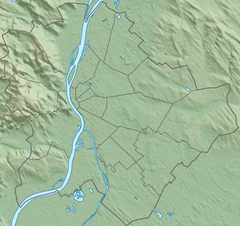| This article relies excessively on references to primary sources. Please improve this article by adding secondary or tertiary sources. Find sources: "Széchenyi thermal bath" – news · newspapers · books · scholar · JSTOR (June 2013) (Learn how and when to remove this message) |
| Széchenyi Thermal Bath | |
|---|---|
 | |
| Location | City Park, Budapest, Hungary |
| Coordinates | 47°31′07″N 19°04′55″E / 47.51861°N 19.08194°E / 47.51861; 19.08194 |
| Built | 1913 |
| Architect | Győző Czigler |
 | |
The Széchenyi Medicinal Bath in Budapest (IPA: [seːtʃeːɲi], Hungarian: Széchenyi gyógyfürdő) is the largest medicinal bath in Europe. Its water is supplied by two thermal springs, one at 74 °C (165 °F) and the other at 77 °C (171 °F).
Components of the thermal water include sulfate, calcium, magnesium, bicarbonate and a significant amount of metaboric acid and fluoride.
History
From 1865 to 1875, Vilmos Zsigmondi drilled a hole beneath the park that was 975.36 meters deep (3,200 feet). This would later become the source of thermal water that would supply the spa.
During the planning phase from the 1880s, the bath had originally been referred to as the Artesian spa (Artézi fürdő), but when it opened on June 16, 1913, it was officially named Széchenyi spa (Széchenyi gyógyfürdő) after István Széchenyi
The bath, located in the City Park, was built in Neo-Baroque style to the design of Győző Czigler. Construction began on May 7, 1909 with designs by architect Eugene Schmitterer. The pool construction cost approximately 3.9 million Austro-Hungarian korona. The total area covered was 6,220 square metres (67,000 sq ft). More than 200,000 bathers visited the spa in 1913. This number increased to 890,507 by 1919. At that time the Bath consisted of private baths, separate steam-bath sections for men and women, and male and female "public baths". The complex was expanded in 1927 to its current size, with 3 outdoor and 15 indoor pools. It is now possible for both sexes to visit the main swimming and thermal sections.
After the expansion, the thermal artesian well could not supply the larger volume of water needed, so a new well was drilled. The second thermal spring was found in 1938 at a depth of 1,256 metres (4,121 ft), with a temperature of 77 °C (171 °F). It supplies 6,000,000 litres (1,600,000 US gal) of hot water daily. Between 1999 and 2009 the Széchenyi thermal bath was refurbished in a complete renovation.
Units

The baths have pools of varying temperature. The outdoor pools (swimming pool, adventure pool and thermal sitting pool) are 27 to 38 °C (81 to 100 °F). The swimming pool's depth is 0.8 to 1.7 metres (2 ft 7 in to 5 ft 7 in). The adventure pool's depth is 0.8 metres (2 ft 7 in). Guests can use the water streaming, whirlpool and massaging water beamand. The indoor pools are of varying temperatures, between 18 and 38 °C (64 and 100 °F). The complex also includes saunas and steam.
Gallery
-
 Steam rising from the baths at night.
Steam rising from the baths at night.
-
Men playing chess in the baths.
-
 An aerial view of the bath complex.
An aerial view of the bath complex.
-
An aerial view of the three large outdoor baths.
-
-
-

-
 A view of the baths' Neo-Baroque architecture.
A view of the baths' Neo-Baroque architecture.
References
- Trope, Nick (August 21, 1994). Reading Eagle. Reading Eagle.
- ^ "Széchenyi Bath". Budapest: Hungária Koncert Kft. Retrieved 2015-07-13.
- "Bath Units of Széchenyi Thermal Bath | BGYH". Budapestgyogyfurdoi.hu. Archived from the original on 2009-12-15. Retrieved 2012-08-15.
External links
- Website
- (in English) Budapest Spas and Hot Springs entry
- (in German) Thermen in Budapest
- (in English) The experience of visiting Szechenyi and other baths in Budapest
| Thermal Baths of Hungary | |
|---|---|
| Budapest | |
| Others | |

